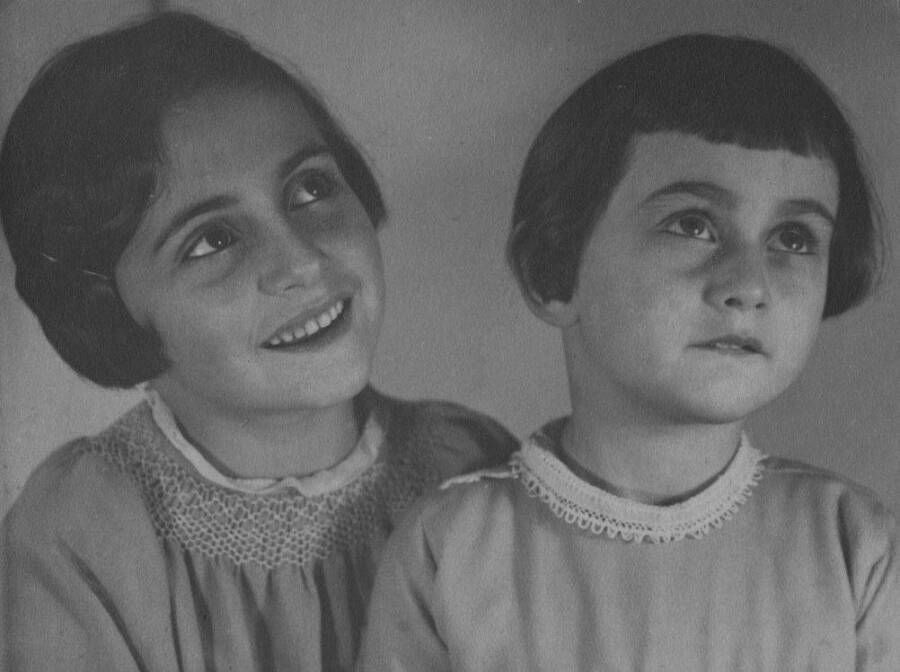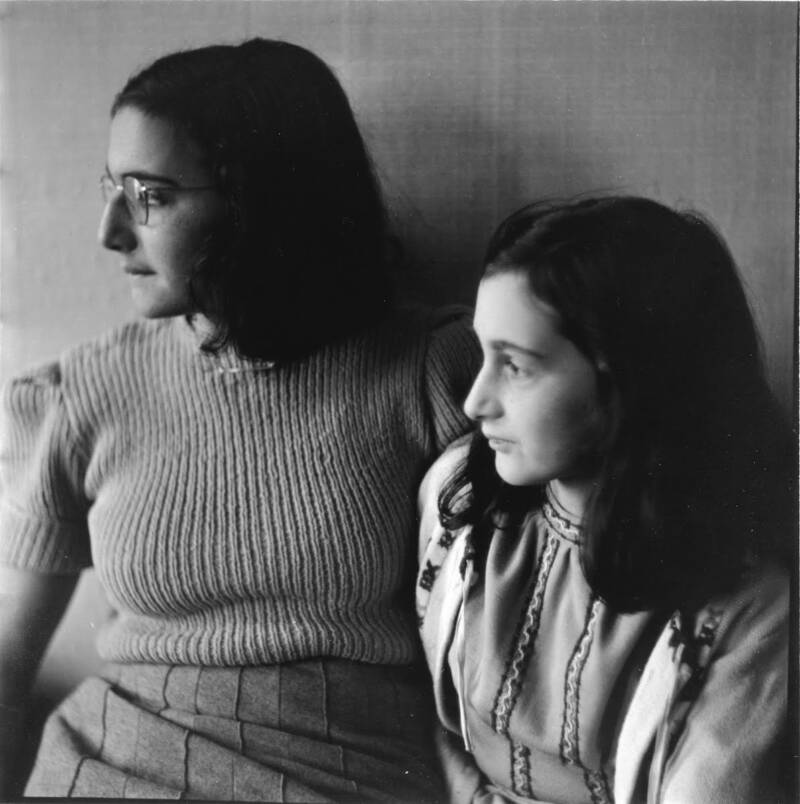Although friends, family, and Anne Frank's diary have shed some light on Margot Frank, her own diary was lost — leaving much of her inner life a mystery.

Roos van Gelder/The Anne Frank HouseMargot Frank, right, laughing with a friend from her rowing team. Amsterdam, 1941.
In a diary entry from October 1942, Anne Frank describes lying in bed with her sister, Margot Frank, and talking about their diaries. Margot asks if she can read Anne’s; Anne says she can read parts of it, and Margot agrees to let Anne read her own diary as well. But while Anne’s diary was preserved and published after their deaths in 1945, Margot’s was lost.
As such, Margot Frank can be a difficult figure to understand. Whereas Anne’s diary entries provide a vivid and moving account of their family’s experience during the Holocaust, Margot’s words, observations, and impressions have largely been lost to time.
That said, Margot Frank’s friends and family kept her memory alive after she died alongside her sister at the Bergen-Belsen concentration camp.
This is her story.
Margot Frank, Anne Frank’s ‘Brainy’ Sister

Anne Frank HouseMargot Frank and Anne Frank in Germany. 1933.
Margot Frank was born on February 16, 1926, in Frankfurt, Germany, the first child of Otto and Edith Frank. The Anne Frank House notes that Margot was described as “neat and careful” from a young age, and that her first school report lauded her as “very diligent!”
In 1929, Margot’s younger sister Anne Frank was born. The girls were different. In later diary entries, Anne described herself as the family’s “mischief maker” and Margot as “brainy” and “brilliant.” But both their lives changed in the 1930s, when Adolf Hitler and the Nazi party rose to power.
Unsettled by Nazis who marched through the streets chanting anti-Semitic slogans — and discouraged by the worsening economic conditions in Germany — Otto and Edith Frank decided to leave the country. They moved from Germany and settled in the Dutch city of Amsterdam.
Margot was enrolled in a Dutch school where, despite the challenge of learning a new language, she swiftly excelled. The Anne Frank House notes that she scored 3 out of 5 by the end of the year, and improved her grade to 4 out of 5 by the end of primary school.
In addition to excelling in school, Margot also made friends and started rowing and playing tennis. But though she lived a normal life, the threat of Nazi Germany was never far from her mind. In September 1939, World War II began with the Nazi invasion of Poland. And Margot worried that the Netherlands would be next.

Anne Frank FondsMargot Frank in Amsterdam in 1939. In 1940, Nazi Germany invaded the Netherlands and quickly occupied the country.
“We often listen to the radio, for these are stressful times,” Margot wrote her American penpal on April 27, 1940. “We never feel safe, because we border directly on Germany and we are only a small country.”
These were prophetic words. Two weeks later, on May 10, 1940, Germany invaded the Netherlands and occupied the country. Margot Frank’s life — and the life of her family — would never be the same.
The Frank Family Goes Into Hiding
The Nazi invasion changed everything for the Frank family. Life for Dutch Jews became restricted under Nazi rule, and Anne and Margot had to attend a Jewish-only school. Then, on July 5, 1942, Margot received a summons for “labour duty in Germany.” Her family decided to go into hiding instead.
They moved into a secret annex behind Otto’s office at Prinsengracht 263, where the family would spend the next two years alongside four other people. Anne, who had received a diary for her 13th birthday just a few weeks earlier, began to record her experience of living there, including her fluctuating relationship with her older sister.

The Anne Frank HouseMargot Frank with her sister, Anne, shortly before the girls went into hiding with their family in July 1942.
In one entry, Anne describes Margot as “weak-willed and passive.” In another, she details how their father, Otto, seems to prefer Margot, the “cleverest, the kindest, the prettiest, and the best.”
Life in the annex wasn’t easy for the two teenage girls. At one point, Anne began to develop a close relationship with Peter van Pels, one of the eight people hiding there, and worried that it would make Margot jealous. But Margot reassured her younger sister that she was happy for Anne since they were “already missing out on so much here.”
And Anne seemed to grow closer with her sister as time went on.
“Margot’s much nicer,” she wrote in her diary at the beginning of 1944. “She seems a lot different from what she used to be. She’s not nearly as catty these days and is becoming a real friend. She no longer thinks of me as a little baby who doesn’t count.”
Sadly, the sisters never had a chance to deepen their relationship further. On Aug. 4, 1944, the Frank family and the others in the annex were arrested after someone betrayed them.
Margot Frank’s Death At Bergen-Belsen
The Frank family was first sent to Camp Westerbork, and then to Auschwitz-Birkenau, where Otto was separated from Edith, Margot, and Anne. Then, in November, Margot and Anne were separated from their mother and sent to Bergen-Belsen concentration camp in northern Germany.
Life in the camp was a “hell where people were not exterminated immediately, but died from hunger, dysentery, typhus, cold, exhaustion, beatings, torture, and exposure,” Nanette Konig, a former classmate of Anne’s who was imprisoned at Bergen-Belsen at the same time as the Frank girls, remembered according to a 2017 article from the Times of Israel.

Public DomainBergen-Belsen concentration camp shortly after it was liberated by British troops in April 1945.
Anne and Margot Frank slept in a thin tent upon straw mattresses crawling with lice. And when typhus began to spread at the beginning of 1945, both Anne and Margot got sick. Their exact date of death isn’t known, but a friend of theirs recalled in a 2015 report by the Anne Frank House that by February the two Frank girls “simply weren’t there anymore.” They probably died that month.
Margot Frank was 18 or 19. Anne was 15.
They were two of 35,000 people who died at Bergen-Belsen between January and April 1945 from illness, starvation, and exhaustion. In a cruel twist of fate, the camp was liberated by British troops just weeks after their deaths.
What Happened To Margot Frank’s Diary?
At the end of the war, Otto Frank returned to the Netherlands. He was the only member of the Frank family to survive.

Arnold Newman/Anne Frank HouseOtto Frank in the annex where he, Edith, Margot, and Anne hid for two years.
Soon afterward, he got in contact with his former secretary, Miep Gies, who had helped hide the family during the war. She had saved Anne’s diary from the annex after the Franks were deported, intending to one day give it back to her. Instead, she gave it to Otto.
Otto eventually decided to publish the diary, which consequently became one of history’s most famous accounts from the Holocaust and was translated into more than 70 languages. But though it tells Anne’s story in vivid, moving detail, Margot Frank’s story is lost. Her diary has never been found.
“I think it’s wonderful what you are doing for Anne, but I think it’s a pity that nothing is mentioned anymore about Margot,” Margot’s best friend Jetteke Frijda told Otto, according to a 2011 article from Moment Magazine. “She is also worthy of being mentioned.”
That said, according to a 2011 Independent article, Frijda also believes that Margot — being the less extroverted of the two sisters — “would not have wanted her private thoughts exposed to the world.”
Margot Frank’s story will never be fully told. Her diary is lost to time. But Margot’s memory has been maintained by her family and friends, who remember her as much more than Anne Frank’s sister.
After reading about Margot Frank, Anne Frank’s sister, discover the stories of nine people who put their lives on the line to help others during the Holocaust. Or, look through these photos of the liberation of Auschwitz.





